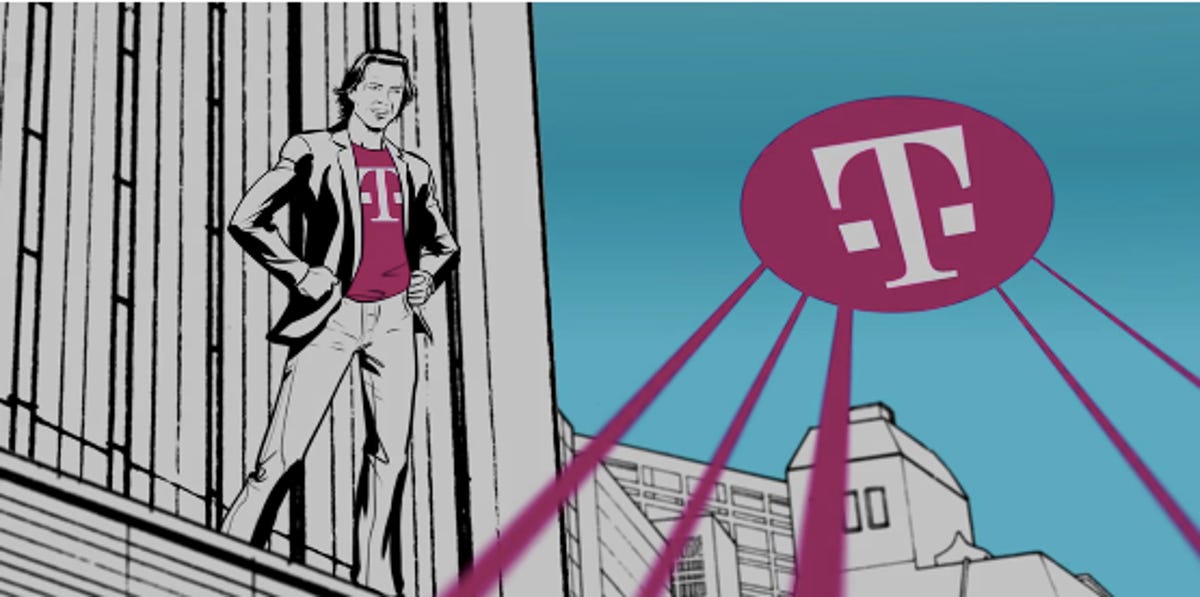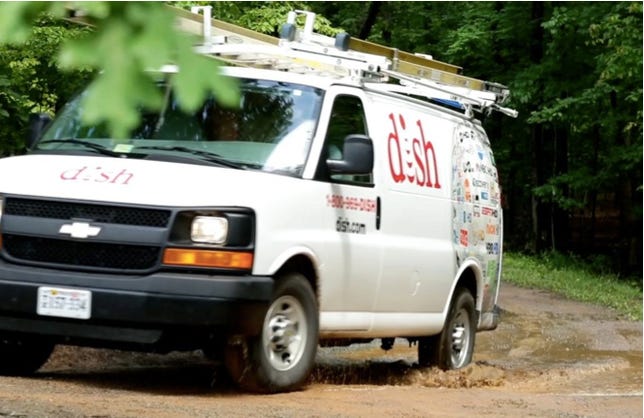
T-Mobile
T-Mobile is ready to step up as a major wireless operator that can go toe-to-toe with Verizon Wireless and AT&T as a legitimate national player. But it says it needs the government’s help to do it.
The fourth-largest carrier in the US has its eyes on next year’s Federal Communications Commission-run auction of wireless spectrum, the radio airwaves critical to sending text messages, videos and phone calls across the air, and the company — specifically CEO John Legere — has already been vocal about creating a level playing field. T-Mobile went so far as to produce a comic book-style cartoon that depicts Legere as a superhero revolutionizing the wireless industry. The villain? A two-headed man in a blue and red suit, representing the two largest wireless operators.
Related stories
- How the future of US wireless service hangs on a government auction
- FCC rakes in $45 billion from wireless spectrum auction
- Surprise! Dish Network emerges as major wireless player after FCC auction
- Six burning questions if T-Mobile, Dish Network actually get together
- Which wireless carrier is king? One testing firm weighs in
“There’s a dark force plotting in the shadows,” the voice-over says in the video posted on Twitter late Monday. “AT&T and Verizon, the Duopoly.”
With next year’s spectrum auction playing a crucial role in shaping the future of the US wireless industry, there’s no company that has more to win or lose than T-Mobile. The self-proclaimed Uncarrier has been shaking up the industry through moves like the elimination of customer contracts. But it is in desperate need of more spectrum in order to propel its coverage beyond the major metropolitan markets. Without that coverage boost, T-Mobile just isn’t a credible alternative to the Big Two.
“This is very much a make-it-or-break-it auction for T-Mobile,” said Harold Feld, a senior vice president at the consumer watchdog group Public Knowledge.
T-Mobile is the most interesting player in the upcoming auction for many reasons. As a rumored takeover target for Dish Network and maverick Chairman Charlie Ergen, the possibility of a deal between the two hangs over the proceedings. In addition, T-Mobile has become the face of the push to set aside a larger swath of spectrum for smaller players, so deeper-pocketed AT&T and Verizon don’t dominate the auction. Regulators had already promised to carve out some spectrum for T-Mobile and other smaller carriers to bid on, but T-Mobile is pushing the agency for even more spectrum.
The FCC is expected to vote on T-Mobile’s proposal to amend the rules next month. Details of the proposal are expected to start coming out Thursday. (Read more about the wireless spectrum auction and the push by the regional carriers here.)
“We absolutely think we can be No. 1 or No. 2 in the market,” T-Mobile’s chief operating officer, Mike Sievert, said in an interview in April. “But we need the appropriate assets to reach that top spot.”
Hitting a spectrum ceiling
Two years ago, T-Mobile began a marketing blitz that helped transform the company into the fastest-growing wireless company in the country. It all started with the “Uncarrier” campaign, which set out to eliminate the things about the industry that annoyed consumers.


CNET
The strategy has been a success. And in a market where new customers have been hard to come by, T-Mobile has been signing them up in droves. Over the last several quarters, the total number of new T-Mobile customers who pay at the end of each month — known in the industry as postpaid subscribers — has outstripped the rest of the industry.
“T-Mobile has figured out some cool ways to break long-standing habits,” said Michael Levin, a partner and co-founder of the marketing research firm Consumer Intelligence Research Partners.
While Levin applauds T-Mobile’s efforts, he says the company will eventually hit a natural limit in terms of the number of customers it can steal from these rivals. Inexpensive service plans and slick marketing can only go so far. The quality and reach of a mobile carrier’s network eventually matter. And T-Mobile requires improvements in both areas.
The company serves customers mostly in urban areas and some suburban markets. But the further from a major city you get, the worse the network performs, and in many areas there is no coverage at all.
“To go further, they have to improve on network quality, and that includes building out their infrastructure,” Levin said.
A network limited to urban markets may be fine for a company that is content being No. 4. But if it wants to surpass AT&T and Verizon, T-Mobile needs better coverage in key suburban markets and even some rural regions.
The biggest reason customers cite for leaving T-Mobile is its network, according to the market research firm Consumer Intelligence Research Partners. In a recent survey, nearly 40 percent of departing customers identified the network as their reason for switching services.
Some consumers don’t dare give T-Mobile a shot. Take Wendi Moore of Port Orchard, Wash. The nurse said she would love to sign up for T-Mobile’s $100-a-month unlimited data plan for her and her 15-year-old daughter, which would halve the bill she currently pays to AT&T, which often includes data overage charges of $20 to $40. But she can’t switch because T-Mobile’s service simply doesn’t work where they live.
“We’re only a ferry ride away from Seattle,” she said. “But still no T-Mobile signal.”
How the auction can help
Filling in those dead zones will go a long way to legitimizing T-Mobile’s service. That’s where next year’s spectrum auction comes in.


CNET/James Martin
The so-called incentive auction — named because the FCC is incentivizing TV broadcasters to sell off their unused spectrum — is valuable because the wireless licenses that are up for grab run at a lower frequency or band, which means they’re able to travel longer distances and penetrate obstacles like buildings.
The low-band spectrum will make it less expensive by a factor of three or four to expand T-Mobile’s network to rural and suburban markets, according to T-Mobile Chief Technology Officer Neville Ray.
Because a signal can travel over longer distances using low-band spectrum as opposed to higher-frequency spectrum, wireless operators can build fewer towers to cover the same geography and population. This reduces the capital expenditure and also lowers the ongoing operational costs. Because of those properties, wireless operators see it as a must for expanding a wireless network in less populated areas.
“You simply have to have low-band spectrum to compete in some of these geographies,” Ray said.
T-Mobile has managed to get its hands on some low-band spectrum, acquiring it from Verizon through a spectrum swap. It has also bought some low-band spectrum from smaller rural providers, such as BEK Communications Cooperative and Dakota Central Telecommunications Cooperative.
The company has already put this spectrum to use expanding its coverage in some suburban markets. It’s also used the spectrum to improve coverage within cities. But Ray said the company still needs more.
“Our geographic coverage with low-band spectrum is not as strong as we need it to be,” he said. “It’s not national. And more importantly the volume of spectrum is thin.”
A call to arms
T-Mobile’s executives have painted the upcoming spectrum auction as the key to whether there is competition in the future. They say that how the FCC’s rules for the auction shake out will not only determine T-Mobile’s fate, but whether consumers will have any choice of wireless carrier in the future.
“This is really about whether or not as a matter of public policy the federal government wants a vibrant multi-player competitive wireless industry,” Sievert said. “The federal government has to decide when designing this next auction whether having four vibrant competitors in the marketplace, each with adequate assets to compete over the long haul, is in the interest of the American consumer.”
KA-POW!! That is the sound of us saving wireless competition! We need your help to #DefeatDuopoly! Watch this! https://t.co/R56ap3BZkW
— John Legere (@JohnLegere) June 23, 2015
The FCC has made it clear it wants four national wireless operators. But T-Mobile believes it’s up to the government to ensure they can all adequately compete.
This goes to the heart of why T-Mobile is asking the FCC to set aside more wireless spectrum for it and other competitive operators to bid on without interference from AT&T and Verizon in the upcoming auction, Ray said. He said that in order to build a 4G LTE network with sufficient capacity, T-Mobile needs a wide swath of spectrum in each market.
If you think of spectrum as a highway, the wider the road, the more cars or data can travel on that highway. So if a road is restricted to a single lane, you’re more likely to see traffic jams resulting in a slower connection, delayed downloads and buffered videos.
The average smartphone user in North America consumes 2.4 gigabytes of data each month, which is equivalent to about 10 hours of streaming video, according to telecom equipment maker Ericsson. By 2020, that usage is expected to increase sixfold to 14 GB.
Feld agrees that this is about making sure there is enough spectrum to go around to meet the government’s stated goal of having four national wireless competitors.
“T-Mobile may win enough spectrum to meet its needs,” he said. “But they may end up as the only national competitor that is viable.”
The Dish route
While T-Mobile’s executives are playing up the importance of this auction, it’s unclear whether losing out on spectrum would be a death knell for the company.
T-Mobile’s success over the past couple of years has made it an attractive acquisition target. There have been several reports that satellite TV provider Dish Network is interested in buying the operator. A tie-up between these two companies would give T-Mobile access to a large stash of unused wireless spectrum that Dish has been amassing over the last few years. Dish was the second-largest bidder in the last spectrum auction, which ended in January, coming in behind AT&T and ahead of Verizon.


Dish Network
The problem with a combined Dish and T-Mobile is that the spectrum Dish would bring to T-Mobile is similar to the type of spectrum it already owns. Dish doesn’t own any low-band spectrum, which is what T-Mobile really needs in order to grow its business.
“As great as it sounds to imagine all of the wonderful opportunities made possible by a spectrum-rich T-Mobile…T-Mobile would still need low-band spectrum,” Craig Moffett, an analyst with MoffettNathanson, wrote in a research note earlier this month. “There would be no less urgency for them to participate in the upcoming incentive auction than there is now.”
There is no combination of assets with T-Mobile that would change the company’s focus on competing aggressively in the upcoming auction, Sievert said.
“We will find a way to compete regardless of what happens in this auction,” he said. “But our ability to bring the kind of change that really benefits all consumers in this industry hinges on whether or not the government makes the right choices in designing this auction.”





